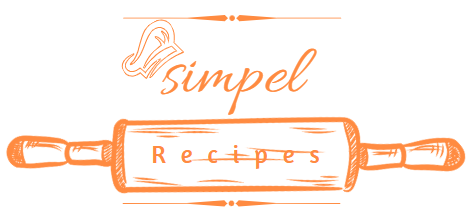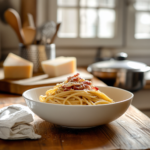Looking for the real answer to what ingredients are in Carbonara? You’re not alone! This creamy, dreamy pasta dish has stirred up debates for decades, especially between traditionalists and modern foodies. Is cream allowed? Should you use guanciale or pancetta? And what cheese gives Carbonara its iconic tang?
In this ultimate guide, we’re diving fork-first into the essential and optional ingredients that make up this beloved Italian staple. If you’ve ever found yourself wondering what ingredients are in carbonara?, this guide will walk you through the traditional elements, modern twists, and must-know techniques.
Sure! Here’s a shortened and SEO-optimized version of Part 1, keeping your focus keyphrase “what ingredients are in carbonara” naturally included, while improving clarity and readability:
Part 1: What Ingredients Are in Carbonara?
A Quick Look at the Classic Components
Ever wondered what ingredients are in carbonara? You’re not alone—this rich Roman pasta dish is often misunderstood. While many modern recipes add extras like cream or garlic, traditional Italian carbonara sticks to just five simple ingredients: pasta, guanciale, egg yolks, Pecorino Romano, and black pepper.
The 5 Essential Carbonara Ingredients
- Pasta – Typically spaghetti, but rigatoni or bucatini also work well.
- Guanciale – Cured pork cheek, prized for its rich flavor and melt-in-your-mouth texture.
- Eggs – Mostly yolks, used to create a creamy sauce without cream.
- Pecorino Romano – Sharp, salty cheese that brings the whole dish together.
- Black Pepper – Freshly cracked for that subtle, peppery kick.
Each ingredient in carbonara has a purpose—together, they create a bold, creamy sauce with no need for extras. So the next time you ask yourself what ingredients are in carbonara, remember: simplicity is the secret.
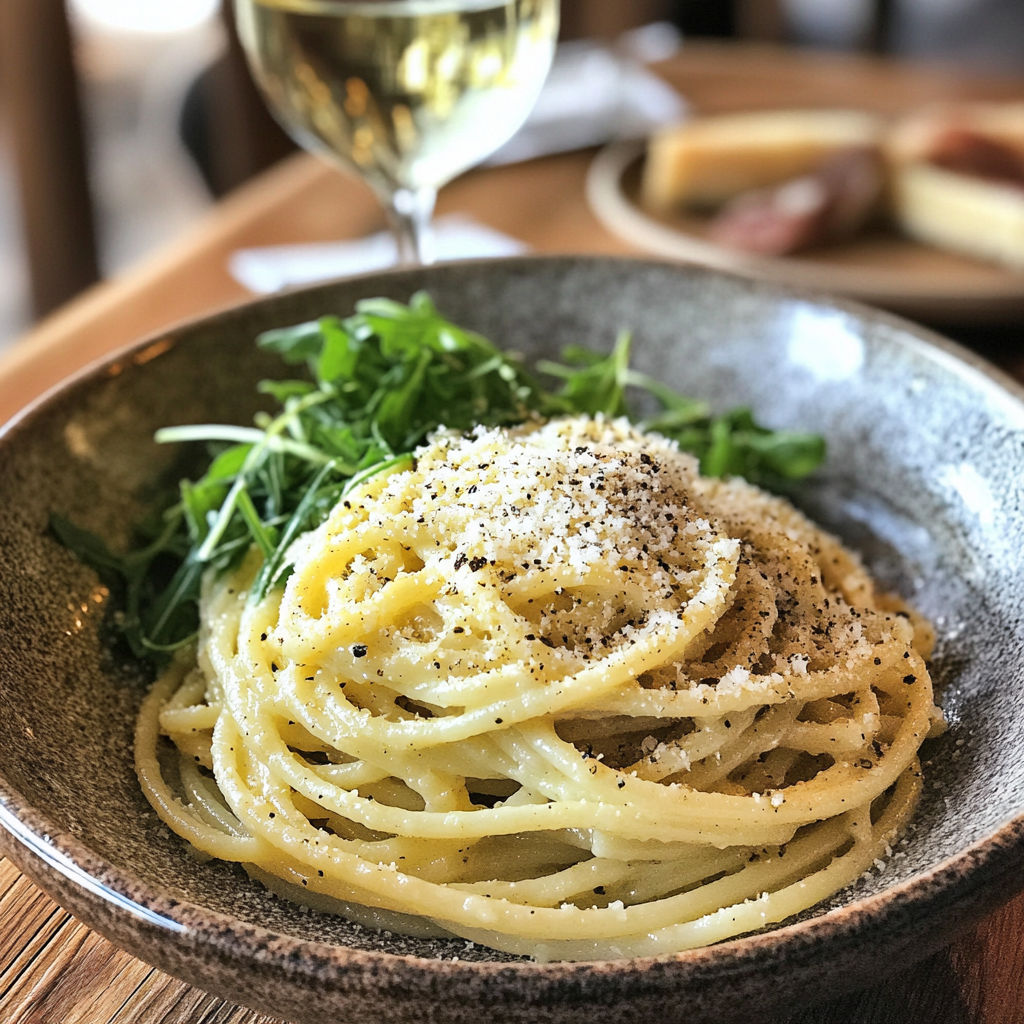
Part 2: The Origins of Carbonara
A Slice of History Behind Carbonara Ingredients
Before we dive into modern twists and substitutions, it’s worth asking—where did Carbonara come from, anyway? While the exact origins are shrouded in a little mystery (and a lot of speculation), what we do know is that Carbonara is deeply rooted in Italian culinary tradition—specifically, Roman cuisine.
The earliest written recipes appeared around the mid-20th century, but that doesn’t mean Carbonara is some new kid on the block. In fact, its roots likely stretch back much further, born from humble, rustic beginnings.
Debated Origins: Fact or Foodie Fiction?
1. The Coal Miners’ Tale
One theory suggests that the name “Carbonara” comes from “carbonari,” the Italian word for coal miners. Legend has it, these miners cooked the dish with easy-to-carry ingredients like pasta, cured meat, and aged cheese. Sounds legit, right?
Except, there’s little historical evidence to back it up. Still, the name stuck.
2. The Post-War American Influence Theory
Another intriguing possibility? American soldiers during WWII. After the liberation of Rome, U.S. troops brought with them powdered eggs and bacon. Italians—known for working culinary magic with whatever’s on hand—may have adapted these items into what eventually became Spaghetti alla Carbonara.
This theory aligns with the timing of its first written appearances and would explain why non-traditional ingredients (like cream and bacon) slipped into international versions.
Carbonara and the Evolution of Italian Cuisine
Rome is known for its iconic pasta dishes—Cacio e Pepe, Amatriciana, and of course, Carbonara. Each one features minimal ingredients, bold flavors, and a focus on technique over extravagance. What sets Carbonara apart, however, is its richness, and that silky, custard-like sauce formed by eggs and cheese.
Despite its unclear past, one thing’s for sure: Carbonara is more than just comfort food—it’s a symbol of Italian culinary identity.
Even respected food institutions like Wikipedia acknowledge the disputed history of Carbonara, reflecting its transformation over the years into a global pasta phenomenon.
Traditional vs. Modern Interpretations of Carbonara Ingredients
Purists Say No Cream Allowed
Ask any Roman nonna, and she’ll tell you—real Carbonara has no cream. The creaminess should come from emulsifying starchy pasta water with the fat from guanciale and the eggs.
But hey, people get creative. And who are we to stop them?
Modern Cooks Add Garlic, Onions, and Cream
Outside of Italy, it’s not unusual to find Carbonara recipes with:
- Heavy cream
- Garlic
- Onions
- Mushrooms
- Even peas (gasp!)
Sure, they make a tasty pasta dish. But if you’re asking what ingredients are in Carbonara, the answer depends on whether you’re chasing authenticity or innovation.
Part 3: Core Ingredients of Traditional Carbonara
The Real Ingredients in Carbonara Sauce: No Cream, No Kidding
To truly understand what ingredients are in carbonara?, you need to know the role each component plays in achieving the perfect creamy texture—without cream. Now that we’ve cleared up the confusion about Carbonara’s history, it’s time to zoom in on the real deal. What exactly goes into a classic Carbonara recipe? Let’s break it down—ingredient by ingredient—so you’ll never mistake Alfredo for Carbonara again.
Pasta: The Heart of the Dish
Not just any noodle will do. Spaghetti is the gold standard when it comes to traditional Carbonara, though rigatoni and bucatini are also excellent choices. The key is using a pasta with enough bite to hold up under that rich, silky sauce.
Tip: Use bronze-cut pasta if you can—it has a rougher texture that grips sauce like a pro.
Why It Matters
Pasta acts as both a vehicle and a contributor to the sauce’s texture. The starch it releases is vital for emulsifying the guanciale fat and egg mixture.
Guanciale: Carbonara’s Signature Flavor
Here’s where many folks unknowingly go rogue. Guanciale—not pancetta, and definitely not bacon—is the fatty, salty, melt-in-your-mouth pork that defines authentic Carbonara.
What Is Guanciale, Exactly?
It’s cured pork cheek, aged with salt, pepper, and sometimes herbs. As it cooks, it renders its luscious fat, which becomes the base of the sauce.
Can You Substitute?
If you must substitute, pancetta is the next best option, but it lacks guanciale’s depth. Bon Appétit recommends pancetta in modern adaptations—but again, it’s not the same.
Egg Yolks: The Creamy Secret
No cream? No problem. Egg yolks are what give Carbonara its velvety texture. They’re whisked with cheese and a bit of starchy pasta water, then gently mixed into the hot pasta to create a glossy, luscious coating.
Whole Eggs vs. Yolks
Traditionalists use just yolks, which makes for a richer texture. Some recipes use a mix of whole eggs and yolks for easier emulsification.
Important: Don’t scramble them! Remove the pan from the heat before adding the egg mixture.
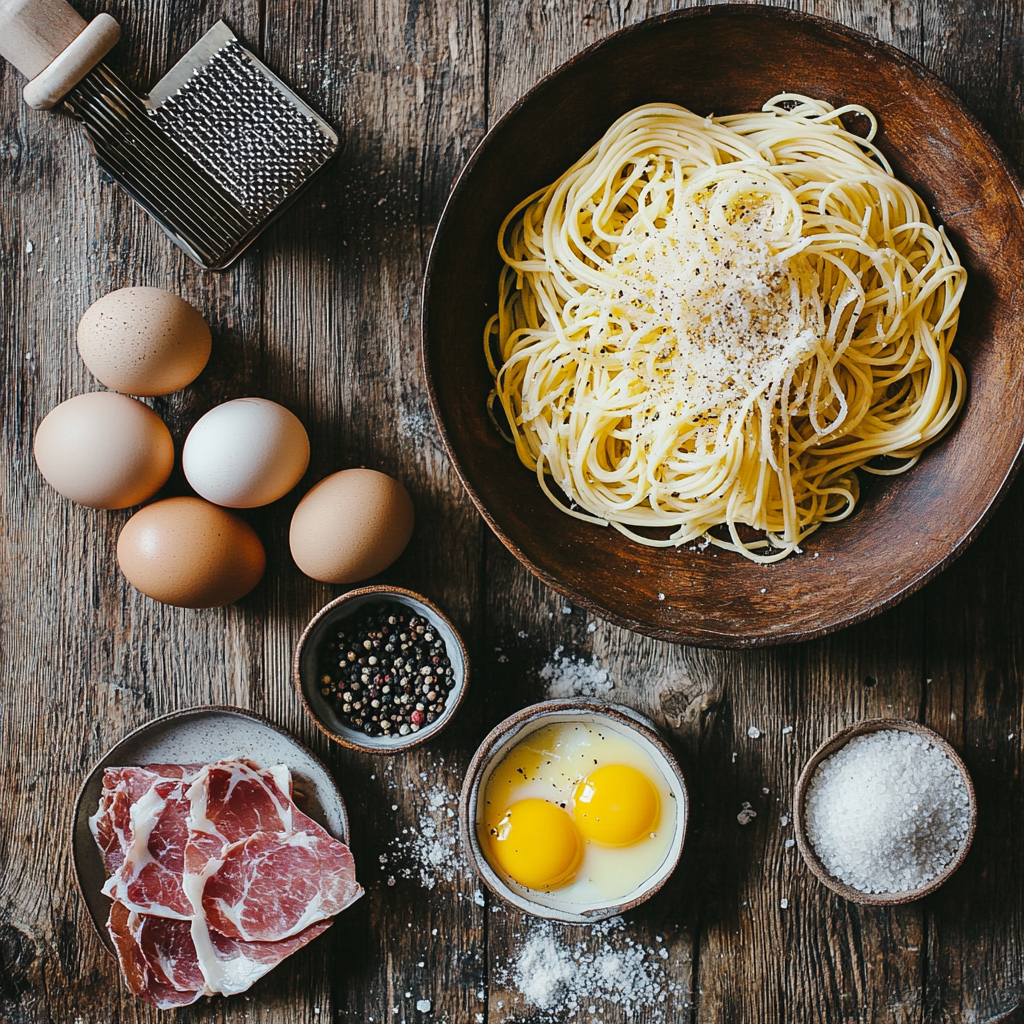
Pecorino Romano: The Bold, Salty Cheese
This ain’t your standard Parmesan. Pecorino Romano is saltier, tangier, and a bit funkier—just what Carbonara needs to cut through the richness of the guanciale and eggs.
Parmesan vs. Pecorino
People often swap Parmesan into the mix, but it lacks the sharpness that makes Pecorino shine in this dish. Still, you can combine them if you prefer a slightly milder flavor.
Black Pepper: Don’t Skip This Final Touch
Not a garnish—a core flavor. Coarsely ground black pepper brings subtle heat and aromatic depth that perfectly contrasts the creaminess of the sauce.
Freshly Ground or Pre-Ground?
Always use freshly cracked pepper. It’s way more fragrant and really makes a difference in the final dish.
The Magic in Simplicity
So here it is—the holy grail of Carbonara ingredients:
- Spaghetti (or rigatoni)
- Guanciale
- Egg yolks
- Pecorino Romano
- Black pepper
That’s all you need to whip up one of the most iconic pasta dishes in the world. No garlic, no onions, no peas, and for the love of Italian cuisine—no cream.So if you’ve been asking yourself what ingredients are in Carbonara, the answer lies in this delicate balance of pasta, pork, eggs, cheese, and pepper. Each ingredient plays a specific role in achieving the creamy, no-cream Carbonara perfection everyone raves about.
Part 4: Variations and Substitutions in Carbonara Ingredients
Tweaking the Ingredients in Carbonara Without Losing the Magic
While purists might scream “sacrilegio!” at the idea of tweaking Carbonara, the truth is—people do modify the recipe. Sometimes it’s due to dietary needs, ingredient availability, or just personal taste. So, if you’re wondering how to make Carbonara without guanciale or without Pecorino Romano, don’t worry—you’re not alone, and you won’t get arrested by the pasta police.
Many people asking what ingredients are in carbonara? are surprised to learn that cream, garlic, and onions are not part of the authentic recipe
Guanciale vs. Pancetta vs. Bacon: What’s Acceptable?
Guanciale: The Gold Standard
As we’ve covered, guanciale is the original fatty, salty star. Its melt-in-your-mouth texture and umami-rich fat are the secret to authentic Carbonara flavor.
Pancetta: The Common Alternative
If you can’t get your hands on guanciale, pancetta (Italian cured pork belly) is the next best thing. It’s less fatty and slightly sweeter but still gives a nice meaty bite.
Bacon: The Outsider
Bacon is smoky, salty, and familiar—but it’s not traditional. Still, if that’s what you’ve got in the fridge, it will make a tasty dish. Just use less salt, and consider skipping any extra oil, since bacon releases more fat than you’ll need.
Pecorino Romano vs. Parmesan: Can You Switch It Up?
Pecorino Romano is sharp, salty, and made from sheep’s milk. Parmesan, or Parmigiano-Reggiano, is milder and nuttier.
You can substitute Parmesan partially or fully depending on your preference. But just know—it’ll change the flavor profile. A 50/50 blend is a happy middle ground many chefs use to balance boldness with subtlety.
The Great Cream Controversy: Is It Ever Okay?
Let’s settle this—real Carbonara doesn’t use cream. The silky texture should come entirely from the eggs and the pasta water emulsifying with rendered fat.
That said, cream is a popular addition in American and British versions because it guarantees a smooth sauce—even if you mess up the eggs.
While it’s not authentic, adding a splash of cream won’t ruin the dish. Just don’t tell your Italian friends.
Garlic, Onions, and Other Non-Traditional Add-Ins
While these ingredients are not found in the original Roman Carbonara, some chefs like to add:
- Garlic: for aromatic depth
- Shallots or onions: for a hint of sweetness
- Mushrooms: for umami and texture
- Peas: for color and freshness
These turn Carbonara into something new—not better or worse, just different.
Dietary Adaptations: Vegetarian and Vegan Carbonara
Vegetarian Carbonara
Replace guanciale with smoked mushrooms, sun-dried tomatoes, or crispy tempeh to bring in that meaty, umami bite. Smoked paprika can also help imitate the deep flavor.
Vegan Carbonara
You’ll need a full transformation here:
- Egg replacement: Use silken tofu, cashew cream, or unsweetened plant-based cream mixed with nutritional yeast.
- Cheese substitute: Nutritional yeast, vegan Parmesan, or almond-based cheese.
- Guanciale alternative: Smoked coconut flakes, vegan bacon, or seared tofu with soy sauce and maple glaze.
It’s not traditional, but it’s definitely delicious in its own right.
Part 5: Cooking Techniques and Tips for Perfect Carbonara
How to Make Carbonara Sauce the Right Way (Without Scrambling Eggs)
Alright, you’ve got your Carbonara ingredients lined up—now it’s showtime. But here’s the deal: even if you’re working with the best guanciale and freshest eggs, you can still mess up the sauce if you don’t follow the right technique.
One wrong move, and you’re staring down a bowl of pasta with scrambled eggs. Yikes. Let’s avoid that, shall we? Knowing what ingredients are in carbonara? is only half the battle—you also need to master the timing and method to avoid scrambled eggs.
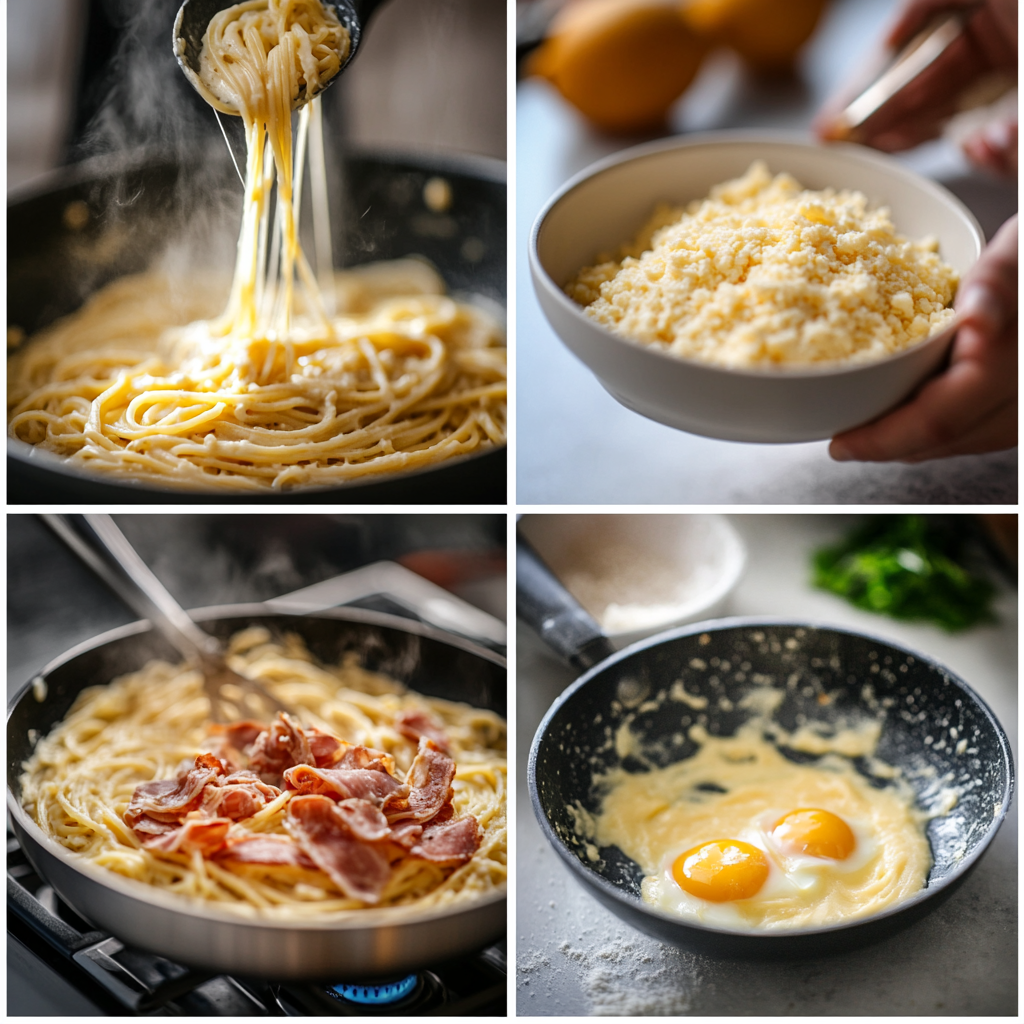
Step-by-Step: How to Cook Authentic Carbonara
🍝 Ingredients List (For 2 servings)
- 200g spaghetti
- 100g guanciale (cut into small strips)
- 2 large egg yolks
- 1 whole egg
- 50g Pecorino Romano (finely grated)
- Freshly cracked black pepper
- Salt (for pasta water)
Optional: A ladle of reserved pasta water
🔥 Cooking Instructions: Foolproof and Flavorful
1. Boil the Pasta
Bring a pot of salted water to a rolling boil. Cook the pasta until it’s al dente. Save about ½ cup of pasta water before draining!
2. Cook the Guanciale
While the pasta’s cooking, add the guanciale to a cold pan (no oil needed). Turn the heat to medium and cook until it’s golden brown and the fat has rendered—about 5–7 minutes. Turn off the heat and set aside.
3. Mix the Eggs and Cheese
In a bowl, whisk together the egg yolks, whole egg, Pecorino Romano, and a generous grind of black pepper. It should be thick and creamy. Add 1 tablespoon of hot pasta water to temper the eggs and prevent curdling.
4. Combine Everything Carefully
Once the pasta is cooked and drained (but still hot!), toss it directly into the pan with the guanciale off the heat. Stir to coat the pasta in the flavorful fat.
Then, slowly pour in the egg-cheese mixture while tossing vigorously. Add a splash of reserved pasta water to loosen the sauce and get that perfect glossy finish.
5. Serve Immediately
Top with a little more cheese and freshly cracked pepper. That’s it—no cream, no nonsense, just real Carbonara.
Common Mistakes to Avoid
❌ Overcooking the Eggs
This is the most common fail. Never add the eggs while the pan is still on the stove. The residual heat from the pasta is enough to cook them gently into a creamy sauce.
❌ Skipping Pasta Water
This starchy liquid is the magic binder. It loosens the sauce and helps everything emulsify without breaking.
❌ Using Cold Ingredients
Cold cheese or eggs will clump. Make sure everything is at room temperature before mixing.
❌ Over-salting
Pecorino and guanciale are both salty, so go light on the salt in your pasta water and taste before adding more.
Nutritional Content (Per 100g of Cooked Carbonara)
| Nutrient | Amount (per 100g) |
|---|---|
| Calories | 385 kcal |
| Protein | 14.2 g |
| Carbohydrates | 41.5 g |
| Sugars | 1.1 g |
| Total Fat | 17.8 g |
| Saturated Fat | 6.9 g |
| Cholesterol | 165 mg |
| Fiber | 1.9 g |
| Sodium | 470 mg |
| Calcium | 140 mg |
Based on traditional Carbonara with guanciale, egg yolks, and Pecorino Romano.
Part 6: Serving and Pairing Suggestions for Carbonara
How to Serve Carbonara Like an Italian
You’ve mastered the Carbonara ingredients and nailed the technique—bravo! But don’t stop there. How you serve Carbonara can really make or break the experience. From plate to pairing, presentation matters just as much as preparation.
So, let’s talk about how to get that restaurant-style finish right in your own kitchen.
Best Practices for Serving Carbonara
🍽️ Serve It Immediately
Carbonara waits for no one. Once the sauce is glossy and clings to each strand of pasta, it’s time to plate. This dish is at its best hot off the pan. The longer it sits, the more it thickens—and not in a good way.
🍝 Twirled, Not Dumped
Instead of plopping the pasta onto a plate, use tongs to gently twirl it into a neat mound. It looks elegant, keeps the portion tidy, and helps the sauce stay in place.
🧂 Finish with Flair
Top each serving with:
- A light sprinkle of Pecorino Romano
- A fresh crack of black pepper
- Optional: a few crisped guanciale bits for texture
That’s it. No parsley, no lemon zest, and definitely no cream drizzle. Keep it classic and let the ingredients speak for themselves.
Dishes and Drinks That Pair Well with Carbonara
🥗 Starters and Sides
Carbonara is rich and creamy, so it’s best to pair it with something crisp, light, and a little acidic to balance out the fat.
Great side options include:
- A simple arugula salad with lemon vinaigrette
- Grilled asparagus or green beans with olive oil
- Fresh tomato bruschetta
🍷 Wine Pairings That Work Wonders
Now for the fun part—wine! You want something dry, slightly acidic, and not too oaky to cut through the richness of the dish.
Recommended wines:
- Frascati: A dry white from Lazio (Carbonara’s home region)
- Pinot Grigio: Crisp and refreshing
- Chianti Classico: For red lovers who want a dry, earthy balance
Want to stick to something non-alcoholic? Try a sparkling water with lemon or an Italian soda—anything fizzy and refreshing does the trick.
Hosting a Carbonara Night?
Why not make it a theme dinner? Start with small plates like olives and charcuterie, serve Carbonara as the star, and finish off with something like a light tiramisu or lemon sorbet.
Set the table with rustic vibes—think wood boards, ceramic dishes, and a bottle of wine. Boom. Instant Italian trattoria.
Part 7: Frequently Asked Questions About Carbonara Ingredients
All Your Carbonara Ingredient Questions—Answered!
Let’s be honest—no matter how many times you’ve made or eaten this dish, Carbonara still sparks a ton of questions. That’s because it seems simple on the surface, but when you start peeling back the layers, there’s a whole lot to learn.
These frequently asked questions are pulled straight from the “People Also Ask” section on Google. So if you’ve been wondering the same things, you’re definitely not alone.
❓ Can I use bacon instead of guanciale in Carbonara?
Yes, you can use bacon—but it’s not traditional. Bacon adds a smoky flavor that’s totally different from the delicate richness of guanciale. If you’re going for authenticity, stick with guanciale or use pancetta as a closer substitute.
That said, if bacon is all you have, go for it. Just reduce the salt in the rest of the dish and keep an eye on the fat—it renders quickly.
❓ What ingredients are in carbonara?
Traditional carbonara includes pasta, guanciale, egg yolks, Pecorino Romano, and black pepper. Nothing else is needed—not even cream. So the next time you wonder what ingredients are in carbonara?, remember: simplicity is key.
Conclusion: What Ingredients Are in Carbonara? Master the Art of Simplicity
So, what really goes into Carbonara? At its heart, this iconic Roman dish is a tribute to the power of simplicity. With just a few key ingredients—spaghetti, guanciale, egg yolks, Pecorino Romano, and black pepper—you can create something utterly rich, comforting, and unforgettable.
Whether you’re a home cook or a pasta purist, knowing what ingredients are in carbonara? is the foundation of making this iconic Italian dish the right way.
PrintWhat ingredients are in carbonara?
Ever wondered what ingredients are in carbonara? This classic Roman pasta dish is beloved worldwide—and often misunderstood. Unlike modern versions with cream or garlic, traditional Italian Carbonara stays true to just five ingredients: pasta, guanciale, egg yolks, Pecorino Romano, and black pepper. The result? A luxuriously creamy, deeply savory pasta without a drop of cream in sight. Follow this authentic Carbonara recipe to master the real deal.
- Prep Time: 10 minutes
- Cook Time: 15 minutes
- Total Time: 25 minutes
- Yield: 2 servings 1x
- Category: Main Course
- Method: Stovetop
- Cuisine: Italian
- Diet: Gluten Free
Ingredients
For 2 servings:
-
200g spaghetti (or rigatoni or bucatini)
-
100g guanciale (cut into thin strips)
-
2 large egg yolks
-
1 whole egg
-
50g Pecorino Romano (finely grated)
-
Freshly cracked black pepper (to taste)
-
Salt (for pasta water)
-
Reserved pasta water (about ½ cup)
Instructions
-
Cook the pasta
Bring a large pot of salted water to a boil. Cook pasta until al dente. Reserve ½ cup of the pasta water before draining. -
Render the guanciale
Place guanciale in a cold pan and heat over medium. Cook for 5–7 minutes until golden and crisp. Remove pan from heat. -
Mix egg and cheese
In a bowl, whisk the egg yolks, whole egg, Pecorino Romano, and plenty of cracked black pepper until creamy. Add 1 tbsp hot pasta water to temper. -
Combine off the heat
Toss hot, drained pasta in the pan with guanciale. Off the heat, add the egg mixture, tossing quickly to coat. Add pasta water little by little until you get a silky sauce.
-
Serve immediately
Top with extra cheese and pepper. Serve hot—Carbonara waits for no one!
Notes
-
Avoid scrambled eggs: Never add the eggs while the pan is on heat.
-
No guanciale? Substitute with pancetta (closest) or bacon (least traditional).
-
Cheese matters: Pecorino Romano is tangier than Parmesan—don’t swap unless necessary.
-
Pasta choice: Use spaghetti for tradition, but bucatini or rigatoni are great too.
-
Make it vegetarian? Try smoked mushrooms or tempeh for a creative umami replacement.
Nutrition
- Serving Size: per 100g
- Calories: 385 kcal
- Sugar: 1.1g
- Sodium: 470 mg
- Fat: 17.8 g
- Saturated Fat: 6,9g
- Unsaturated Fat: 9.5g
- Trans Fat: 0.2 g
- Carbohydrates: 41.5 g
- Fiber: 1.9g
- Protein: 14.2 g
- Cholesterol: 165 mg
Keywords: what ingredients are in carbonara, carbonara recipe, authentic carbonara, spaghetti alla carbonara, traditional carbonara, Italian pasta, no cream carbonara, guanciale recipe, pecorino romano pasta, easy carbonara
